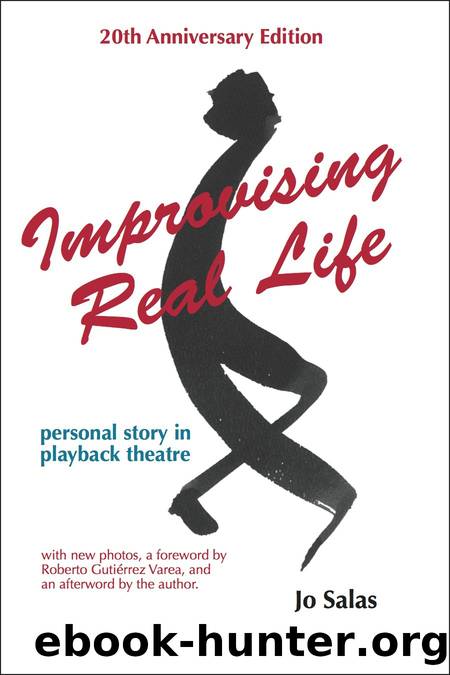Improvising Real Life: Personal Story in Playback Theatre by Salas Jo

Author:Salas, Jo [Salas, Jo]
Language: eng
Format: epub
Publisher: Tusitala Publishing
Published: 2013-05-31T16:00:00+00:00
7
Presence, Presentation, and Ritual
Playback Theatre is intimate, informal, unpretentious, and accessible. But it i s theatre: we are consciously entering an arena that is different from day-to-day reality. To create the heightened atmosphere necessary to any theatrical event, we draw on presenc e , the performers’ carefully focused demeanor and attention; presentatio n , the care taken with the physical, structural, and visual aspects of the performance; and ritua l , the patterns that provide a consistent framework throughout the performance and from one show to another. Through presence, presentation, and ritual, the message is conveyed that these personal stories, these lives, are worthy of our attention and respect.
The Playback paradox of formality and intimacy is encapsulated in a moment at the beginning of one show. The actors enter the stage one at a time. They say their names and tell the audience something about themselves, whatever comes to them in the moment.
“I’m Eve, and today I wrote to a friend who’s been on my mind for quite a while.”
Eve is speaking simply as herself, as one person to another; she hasn’t rehearsed or even planned this statement; and the audience hears it as the unmediated communication that it is. But at the same time, they are receiving her words in the context of the ritual pattern and presence of the actors’ entrance. This different message tells them that this is not just Eve chatting to them; this is a performance, with forms, structures, and intentions. Most of all, it says that Eve’s private experience merits communication in this public context, and that you, the audience, are invited to offer your stories in the same way.
When you watch a Playback Theatre performance, you respond to its heightened, ritualized quality. If it were not there, you would feel its absence. And yet it is one of the hardest things to talk about and teach. We are unused to paying attention to such things in our Western industrial culture. Generally, the elements of ritual and presentation are managed poorly in community events that call for them, moments of transition or celebration like a funeral, a graduation, a piano recital. (An exception that I am aware of is in New Zealand, where the Maori, masters of graceful and functional ceremony, have had a significant influence in this respect on the culture at large. Public occasions, from PTA meetings to official ceremonies, are now likely to be built around ritual structures based in traditional Maori custom. New Zealanders have found that these forms support the purposes for which they have come together—to hear and understand each other, to honor the past and celebrate new beginnings.) In Playback, new practitioners are often perplexed by the challenge of learning how to use ritual, how to perform with presence and conscious presentation.
Presence
Simply by the way they stand, move, listen, relate to one another, the actors can communicate either that they fully understand the depth and power of what they are doing—or the opposite. I’ve often seen actors,
Download
This site does not store any files on its server. We only index and link to content provided by other sites. Please contact the content providers to delete copyright contents if any and email us, we'll remove relevant links or contents immediately.
| Acting & Auditioning | Broadway & Musicals |
| Circus | Direction & Production |
| History & Criticism | Miming |
| Playwriting | Puppets & Puppetry |
| Stage Lighting | Stagecraft |
Call Me by Your Name by André Aciman(18952)
Ready Player One by Cline Ernest(12828)
How to Be a Bawse: A Guide to Conquering Life by Lilly Singh(6686)
Wiseguy by Nicholas Pileggi(4581)
The Kite Runner by Khaled Hosseini(4414)
On Writing A Memoir of the Craft by Stephen King(4204)
The Crown by Robert Lacey(4098)
Audition by Ryu Murakami(4091)
Call me by your name by Andre Aciman(4064)
Harry Potter and the Cursed Child: The Journey by Harry Potter Theatrical Productions(3953)
Gerald's Game by Stephen King(3913)
The Perils of Being Moderately Famous by Soha Ali Khan(3781)
Dialogue by Robert McKee(3574)
Dynamic Alignment Through Imagery by Eric Franklin(3481)
Apollo 8 by Jeffrey Kluger(3196)
How to be Champion: My Autobiography by Sarah Millican(3180)
Seriously... I'm Kidding by Ellen DeGeneres(3098)
Darker by E L James(3086)
History of Dance, 2E by Gayle Kassing(2997)
